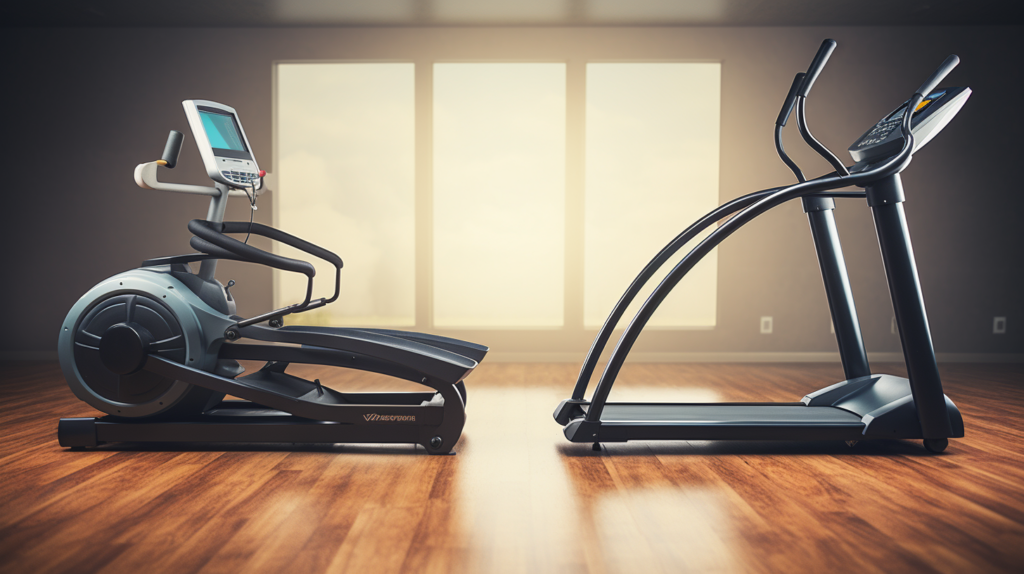Deciding between a treadmill and an elliptical can be a major fitness crossroad for those focusing on weight loss. The treadmill has been a home gym staple since its motorized inception, offering an intuitive way to run indoors.
This article dives into the features and benefits of both machines, guiding you toward the choice that aligns best with your weight-loss journey. You’ll discover key insights to efficiently shed pounds—and just maybe, find that missing piece in your workout puzzle.
Keep reading; a healthier you awaits!
Key Takeaways
- Treadmills burn more calories and are good for high – intensity workouts and running practice. They work well for lower body strengthening but can be hard on joints.
- Elliptical machines provide a full – body workout with low impact on joints, which is great for those with joint pain or recovering from injuries. They help tone muscles and improve cardiovascular health.
- When choosing between the two, consider your fitness goals, joint health, calorie burn desires, budget, space available, and safety concerns. Both machines can support weight loss when used consistently as part of a balanced exercise routine.
Understanding the Treadmill

The treadmill is a staple in gyms and homes alike, revered for its straightforward design that simulates walking or running—a fundamental form of exercise known to boost cardiovascular health.
Let’s dive into the mechanics of this popular cardio machine, evaluating how it stands up not just as an exercise tool but as a potential ally in your weight loss journey.
Pros of Using a Treadmill
Treadmills are a popular choice in the gym and at home. They offer many benefits for those looking to lose weight and get fit.
- Feel Natural: Running on a treadmill feels very natural. You can walk, jog, or run just like you would outside.
- Versatility: Treadmills allow for different kinds of workouts. You can do high-intensity interval training or go for a long steady run.
- All Weather: No matter the weather, treadmills make it easy to exercise. Rain, snow, or sunshine – your workout stays on track.
- Heart Health: Using a treadmill is great for cardiovascular workouts. It gets your heart pumping and improves overall health.
- Bone Strength: Treadmills provide weight-bearing exercises that strengthen bones. This is good for preventing osteoporosis.
- Track Progress: Modern treadmills help you keep an eye on your stats. Speed, distance, heart rate, and calories burned are all tracked.
- Burn Calories: With the right intensity, treadmills can burn a lot of calories. They help with fat loss and boosting your metabolic rate.
- Lower Body Focus: Treadmill exercise targets your leg muscles. It’s excellent for toning thighs and calves.
Cons of Using a Treadmill
While treadmills have some great benefits, they also come with certain drawbacks. Here’s what you need to know about the cons of using a treadmill:
- Joint Impact: Running on a treadmill can be hard on your joints, especially your knees and hips. The constant pounding can lead to pain or injury.
- Posture Problems: Treadmills can cause posture issues if you don’t run correctly. Slouching or leaning too far forward are common mistakes.
- Balance Skills: Using a treadmill doesn’t help improve your balance as much as running outside does. This is because the belt moves under you and doesn’t require as much stability.
- Lack of Scenery: Jogging in place can get boring because the view never changes. You might miss the fresh air and sights that come with outdoor running.
- Limited Muscle Use: Treadmill workouts focus mainly on your lower body. They don’t challenge all muscle groups like some other forms of exercise do.
- Space and Expense: Treadmills take up a lot of room in your home and can be expensive to buy and maintain.
- Overuse Injuries: Using a treadmill too often can cause overuse injuries such as shin splints, especially if you increase intensity too quickly.
- Electricity Needed: Treadmills require power to operate. This means additional electricity costs and not being able to use it during a power outage.
Understanding the Elliptical Machine
Dive into the world of elliptical machines, where low-impact exercise meets full-body engagement. Explore how these versatile trainers can be a game-changer in your fitness routine, offering unique advantages for those focused on cardio health and muscle toning without the harsh impact on joints.
Pros of Using an Elliptical
Elliptical machines offer a unique blend of benefits for those looking to lose weight. They provide an effective workout while being gentle on the body.
- Full-body workout: Elliptical trainers engage your arms and legs, giving you a full-body workout. You can push and pull on the handlebars, working your shoulders and chest.
- Low-impact exercise: Elliptical workouts are easy on your joints. Unlike running, which can be hard on your knees and hips, ellipticals mimic the motion without the harsh impact.
- Calorie burn: Using an elliptical machine can help you burn a lot of calories. This helps with weight loss because burning more calories than you eat leads to fat loss.
- Good for all fitness levels: Whether you’re just starting out or have been exercising for years, the elliptical is suitable. You can adjust the resistance and speed to fit your needs.
- Muscle toning: As well as burning fat, ellipticals help tone muscles in your legs, arms, and core. This makes them amazing for overall fitness.
- Ability to pedal in reverse: Pedaling backwards on an elliptical targets different muscle groups. It adds variety to your workouts and keeps things exciting.
- Cardiovascular exercises: Regular use of the elliptical increases stamina and heart health. This means you can work out longer and harder over time.
- Safe for injury recovery: If you’ve had an injury, an elliptical is often safe to use. It allows you to stay active without risking further harm.
Cons of Using an Elliptical
Elliptical machines offer a great cardio workout. However, they have some downsides that are important to consider.
- Less impact on bones: Ellipticals are low-impact, which is gentler on your joints, but this means they don’t help build bone density like weight-bearing exercises do.
- Limited muscle building: They mainly target lower body muscles and don’t provide the same strength training for bones as running or walking.
- Incorrect posture risk: Users might lean on the machine’s handrails, which can lead to poor form and reduced calorie burn.
- Upper body less challenged: Although ellipticals have moving handles, they often fail to give the upper body a rigorous workout compared to other fitness equipment like rowing machines or weights.
- Can get boring: Using an elliptical can become monotonous because the motion doesn’t change much.
- May overestimate calorie burn: Some machines exaggerate the number of calories burned during a session.
- Potential for neglecting other workouts: Relying too much on the elliptical might lead someone to skip varied physical activity that can boost overall fitness and weight loss.
Calorie Burn: Treadmill vs Elliptical
Understanding how different cardio machines impact calorie burn contributes significantly to weight loss strategies. Treadmills and ellipticals offer varying intensities, which can affect the total calories burned. Let’s dissect this further with a straightforward analysis.
| Treadmill | Elliptical |
|---|---|
| Running on a treadmill can burn a significant number of calories depending on speed, incline, and individual body weight. | Elliptical workouts often result in a lower calorie burn compared to high-intensity treadmill workouts, but variability in resistance can increase intensity. |
| A person weighing 155 pounds may burn approximately 334 calories running at 6 mph for 30 minutes. | The same person might burn about 270 calories on an elliptical for the same duration with moderate effort. |
| Incline settings on treadmills elevate calorie expenditure by simulating uphill running, effectively boosting overall burn. | Higher resistance levels and use of arm components can lead to increased calorie burn on ellipticals, approaching treadmill levels. |
| Intervals and sprints on a treadmill can spike calorie burn, capitalizing on the afterburn effect or EPOC (Excess Post-exercise Oxygen Consumption). | Consistent resistance and cross-training ability on an elliptical can sustain a steady calorie burn and also tap into EPOC. |
Both machines provide avenues for weight loss; user preference, joint health, and workout variety should guide the choice. For optimal results, blending both cardio workouts with strength training sessions is advisable. Remember, consistency is key in the journey to shedding pounds.
Elliptical vs Treadmill: Which is Better for Weight Loss?
When it comes to shedding pounds, the elliptical and treadmill have both carved out reputations as effective cardio machines. But which one reigns supreme in the weight loss arena? Dive in as we unpack the nuances of each machine’s impact on your fat-burning journey, helping you make an informed decision that aligns with your fitness goals.
In-Depth Comparison for Weight Loss
Treadmills get your heart pumping and can lead to high calorie burns, especially when using the incline feature or engaging in high-intensity interval training (HIIT). They simulate natural walking, jogging, or running motions.
This means they’re great for cardio exercises that target lower body muscles. Plus, runners seeking weight loss might prefer treadmills since they allow for varying workout intensity.
Elliptical machines offer a low-impact alternative that still torches calories. They involve upper-body movement as well, giving you a full-body workout. If you have joint issues or are easing back into fitness after an injury, ellipticals may be the way to go.
The cross trainer design of many ellipticals helps reduce stress on knees and hips while helping with weight loss efforts just as effectively as treadmills do.
Key Factors to Consider When Choosing Between Treadmill and Elliptical
Choosing between a treadmill and an elliptical revolves around your personal goals and physical needs. Here are important factors to weigh in on:
- Fitness Goals: Treadmills tend to be better for high-intensity training and running practice, while ellipticals are great for low-impact full-body workouts.
- Joint Health: If you have knee, hip, or lower back pain, an elliptical’s smoother motion can be kinder to your joints than the pounding on a treadmill.
- Calorie Burn: Running on a treadmill usually burns more calories compared to using an elliptical at a similar level of effort.
- Upper Body Workout: An elliptical can engage your whole body including your arms, offering a balanced exercise routine.
- Bone Density: Weight-bearing exercises like walking or running on a treadmill help strengthen bones and improve bone density.
- Variety in Workouts: With a treadmill, you can switch from walking to sprinting. Ellipticals let you change direction and pedal backward for muscle variety.
- Space and Budget: Consider the space you have available; treadmills can be bulky. Also think about how much you want to spend as prices vary.
- Safety Concerns: Treadmills can pose higher risk of falls. Make sure safety features like emergency stop capabilities are in place before deciding.
Conclusion
Deciding between a treadmill and an elliptical for weight loss can be tough. Think about your body’s needs and fitness goals. If you’re okay with impact and want to focus on lower-body strength, the treadmill could be your friend.
Prefer low-impact workouts? The elliptical offers full-body exercise without the strain. Remember, consistency and a healthy diet are key for shedding pounds — no matter which machine you choose!
FAQs
1. Does using a treadmill or elliptical better tackle obesity?
Both treadmills and ellipticals are great for combating obesity, but the treadmill can burn slightly more calories for overall weight loss. Remember, though, pairing cardio equipment with a balanced diet is key!
2. Can an elliptical help me get rid of love handles just like squats do?
Sure thing! An elliptical targets your whole body and can help shape your body, including those tricky love handles. Just mix it up with some strength training to tone up even faster.
3. I’ve heard something about high intensity interval training; does it work on both machines?
Absolutely! High-intensity interval training, or HIIT for short, cranks up your workout on both treadmills and ellipticals. It’s all about switching between fast bursts and cool-down periods—super effective for losing weight fast.
4. What’s this NordicTrack FS10i I keep hearing about? Is that good for exercise too?
The NordicTrack FS10i is pretty fancy—it’s an exercise bike that gives you a solid workout like cycling outdoors would. So if you want health benefits without hitting the road, give it a go!
5. Are there any cardio machines that help if I have chronic pain in my feet?
For sure—if your feet hurt, try out an exerciser called whole-body vibration platforms; they’re gentle yet surprisingly good at helping you stay fit without straining those sore feet.
6. How often should I hop onto the treadmill or elliptical to see results?
Consistency wins here—you’ll want to aim for frequency in your workouts: hop on several times per week and stick with it to melt away those extra pounds.




Leave a Reply